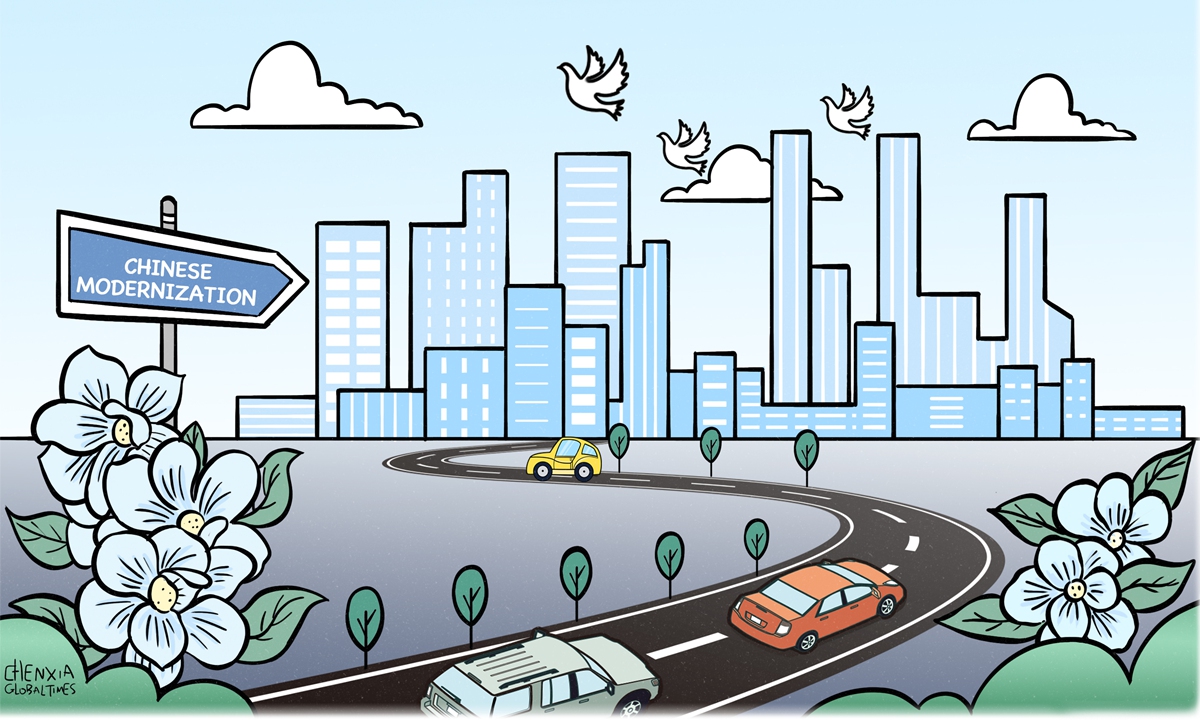
Illustration: Chen Xia/Global Times
The Chinese edition of Voice of America (VOA) recently published an opinion piece, whose title could be translated as "Touting Chinese modernization, is the Communist Party of China (CPC) making the international community really 'understand China' this time?" Against the backdrop of the interpretation and promotion of the concept of "Chinese modernization" during two recent conferences held in China - the Lanting Forum and the "Understanding China-Greater Bay Area Dialogue," the VOA article put forward an absurd point of view: The emergence and promotion of Chinese modernization aim to achieve the effect of denying the principles and standards of Western modernization and constructing China's own set of so-called modernization standards and system, even though the Chinese authorities don't claim so.
It is easy to see that such a view, in many degrees, can represent the misinterpretation of the concept of "Chinese modernization" by some part of the international community, and it has much to do with the "zero-sum game" mentality that the US and the West have always held. In the eyes of some Westerners, the ideas and standards they uphold are universally applicable. Any new ideas or paths are considered a challenge to the existing standards, which is unacceptable.
This is, of course, very biased. For example, their interpretation of the concept of Chinese modernization is a clear reflection of the fact that they have not yet got rid of the "confrontation" and "zero-sum" mind-set on three fundamental issues.
First, why did China introduce the concept of Chinese modernization?
Chinese modernization is a socialist modernization led by the CPC, which shares the common features in modernization in all countries and has Chinese characteristics based on the country's own conditions.
What are the national conditions of China? Xi Jinping, General Secretary of the CPC Central Committee, pointed out in the report to the 20th CPC National Congress that Chinese modernization is "the modernization of a huge population." "China is working to achieve modernization for more than 1.4 billion people, a number larger than the combined population of all developed countries in the world today. This is a task of unparalleled difficulty and complexity; it inevitably means that our pathways of development and methods of advancement will be unique," the report reads.
In fact, the concept of Chinese modernization is based on the practical experience and lessons learned by China itself and developing countries in general. At one time, China, like many developing countries, took the modernization path initiated by the West as a guideline. But soon, it found that the demands for development in countries that embarked on modernization late, such as China, are constrained and limited by the economic, political, cultural, and social constraints of Western countries that reached modernization first.
This is reflected in the conflict and contradiction between the peaceful rise of non-Western countries with a later modernization and the "colonialist" habits of Western countries with an earlier one. The latter type of nations, by virtue of their capital and technological advantages, began a disorderly expansion into various fields, including economy, politics, and culture. As a result, "Western centrism" has prevailed, and economic monopoly, political hegemony, and cultural and ideological prejudice can be found everywhere in the world. This runs counter to the pursuit of countries with a later modernization of equitable development, the political principle of non-interference in others' internal affairs, and the demand to protect their cultural diversity.
Examples of this are commonplace. For instance, when the US and the West seek a global market, they talk about free trade at the international level and demand that countries open their doors to facilitate the free flow of goods: The British Empire levered open the door of China with strong ships and cannons, and decades later, the World Trade Organization was established. But as more and more countries signed up to the rules set by the US and the West, actively promoting globalization and developing amid it, the US felt that it had "suffered losses." Therefore, to ensure its absolute advantage, the country started to talk about "fair trade." It then set up trade barriers, suppressed the development of other countries' industries, and sought "decoupling." This greatly curbed and hindered the development of countries that had come to modernization late.
The unbalanced and uncoordinated development between these two types of countries on their paths to modernization has affected the overall development level of human society. Countries with a later modernization urgently need their own theories and approaches to guide their modernization practices, and Chinese modernization is the scientific theory used to guide Chinese practices.
Second, does Chinese modernization aim to deny the principles and standards of Western modernization completely?
Of course not. As the VOA article points out, Chinese modernization does not completely reject the traditional criteria for modernization. It only adds new elements to the criteria and paths for modernization at this new stage of humankind's civilization development.
For example, Chinese modernization is the modernization of common prosperity for all, not one that leads to the significant disparity between the rich and the poor, as in the US and the West. It is the modernization of material and cultural-ethical advancement, not one revolving around the capital. It is the modernization of harmony between humanity and nature, not one that plunders the environment recklessly. These are not included in the modernization concepts of the US and the West.
It can be said that Chinese modernization integrates economic, political, cultural, social, and ecological civilization construction and promotes the simultaneous development of new industrialization, informatization, urbanization, and agricultural modernization. As a result, a new form of systematic and coordinated modern civilization has been created.
In particular, Chinese modernization emphasizes the need to follow a path of peaceful development. In the report to the 20th CPC National Congress, Xi said that "In pursuing modernization, China will not tread the old path of war, colonization, and plunder taken by some countries. That brutal and blood-stained path of enrichment at the expense of others caused great suffering for the people of developing countries. We will stand firmly on the right side of history and on the side of human progress. Dedicated to peace, development, cooperation, and mutual benefit, we will strive to safeguard world peace and development as we pursue our own development, and we will make greater contributions to world peace and development through our own development."
In many ways, modernization does not equal Westernization, Europeanization, or Americanization. Chinese modernization can enrich the world's choice of path to explore modernization. It is not a challenge but an opportunity; it will not threaten anyone, but only benefit the world and provide a new approach for humanity to achieve modernization.
Third, is the promotion of the concept of Chinese modernization intended to lead the world?
Naturally, it is not. In his opening remarks at the "Understanding China-Greater Bay Area Dialogue," famous Chinese thinker and theorist Zheng Bijian said that in the new journey, Chinese people will work hard together to achieve high-quality development by building a new development pattern and to advance the great rejuvenation of the Chinese nation on all fronts through Chinese modernization. At the same time, China will bring the world new and greater opportunities, he said, noting China is willing to see the development of developed countries, and meanwhile willing to rise peacefully with a large number of developing countries.
In other words, China does not intend to lead the world by reshaping a concept and creating a set of standards. It hopes to use its own practical experience and summaries of its theory to provide a path that can be referred to by the vast number of developing countries that are exploring their modernization paths.
China has never said that Chinese modernization is "universally applicable," nor has it ever asked countries to copy-paste China's experience. Instead, it has repeatedly stressed that "only the wearer of the shoes knows if they fit or not" and that a country should follow a development path that is integrated with its own national conditions, culture, and civilization. One cannot cut their feet to fit the shoes or climb a tree to catch a fish. China has always been committed to promoting world peace and development and building a community with a shared future for mankind. These are not just empty words.
Last but not least, the VOA article argues that the "Understanding China" Conference intends to spread China's voice and ideas globally, to help the international community know and understand China, and to avoid misjudgments. This is actually only half right.
Since its inception, the "Understanding China" Conference has been tasked with two missions: First, to make the world understand China, and second, to allow China to understand the world. The original purpose of this event is to create a platform for two-way communication and equal dialogue, on which we certainly welcome different opinions and discussions, but on the premise of engaging in a frank and friendly manner. It does not matter if there are differences: It is possible to reach a greater "understanding," as long as the exchange is on an equal footing and done in goodwill. This is, of course, not easy, but it is also the significance of the "Understanding China" Conference.
The author is a researcher with the Chinese Academy of Sciences. opinion@globaltimes.com.cn


